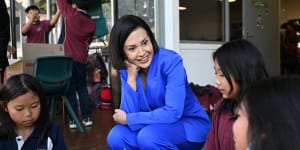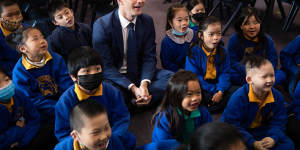Principals were told this week their budgets would be slashed by almost $150 million,while any unspent discretionary school funds would be frozen for the rest of the year.
At a press conference on Wednesday,NSW Education Minister Prue Car repeatedly said the cuts were not connected to the Labor government’s historic teacher pay rise,which boosted salaries of graduate teachers by $10,000.

NSW Education Minister Prue Car said the state had “no choice” to redirect funding to address the ongoing teacher shortage.Janie Barrett
“This adjustment has nothing to do with the teacher pay rise. Anyone that says it is to do with the teacher pay rise is lying. This has nothing to do with the teacher pay rise,” Car said.
Car said cuts were made to “a small amount of discretionary funding” as public school deputies and assistant principals were being required to take on more classroom teaching time to try and plug staff shortages.
“We really have no choice but to actually redirect discretionary funding into getting those executive teachers into classrooms more and more. We believe that this will go some serious way to really digging into the chronic teacher shortage that faces our state,” she said.
States and territories are negotiating funding deals with the Commonwealth to guarantee public schools reach 100 per cent of the – a needs-based funding target a decade ago.
The states provide the bulk of public school funding,80 per cent to the Commonwealth’s 20 per cent,under current agreements.
Federal Education Minister Jason Clare has offered to raise the Commonwealth’s long-standing share of funding for public schools to 22.5 per cent,and in January,Western Australia became the first state to agree.
The 22.5 per cent offer to NSW would mean the state’s public schools would receive an extra $4.1 billion from the federal government over 10 years. NSW has rejected that,demanding the Commonwealth lift its share to 25 per cent,or an additional $8.2 billion over 10 years.

Clare said government funding for schools will be “tied to reforms that help kids catch up,keep up and finish school.”Janie Barrett
In January,education ministers from Victoria,NSW and South Australia wrote to Clare pushing back on the 2.5 percentage point increase.
The latest,tabled in parliament in early April,showed NSW’s contribution to government schools was 78.47 per cent of the SRS,well above the required 71.8 per cent.
A NSW Education Department spokesperson said the impacts of COVID,natural disasters and a school maintenance program had “artificially inflated” the state’s share of funding in 2022.
“These were exceptional circumstances and don’t reflect our agreed funding position,which is that we will be at 75 per cent of the SRS by 2025,” the spokesperson said.
Before the last state election, to reach 100 per cent if no agreement could be made with the federal government.
Clare said the federal government was committed to working with states and territories to get all schools on a path to full and fair funding. “This involves the Commonwealth chipping in and the states chipping in,” he said.
“This won’t be a blank cheque,this funding will be tied to reforms that help kids catch up,keep up and finish school and then go on to TAFE or uni.
“I want this money to glow in the dark. Unlike the last National School Reform Agreement that did nothing to drive accountability and transparency,the next agreement will.”
Car said the federal government “has a larger,more secure and reliable source of revenue” with a greater ability to raise funds.
“With its larger pockets the federal government should fund the lesser amount of the largest sector,” she said.
NSW Education Department secretary Murat Dizdar told principals on Tuesday that school budgets would be reduced by 1.25 per cent and any accumulated unspent discretionary funds frozen over the next year.
Dizdar said public school enrolments had declined since 2019,with about 25,000 fewer students enrolled in public schools last year compared with before the pandemic.
Principals told theHeraldthat the budget cuts and frozen discretionary funding meant upgrades to playgrounds and sports courts would be put on hold while new technology,computers and textbooks could face the chop.
NSW Secondary Principals’ Council president Craig Petersen said some schools would be able to absorb the cuts with minimal impact on student learning. “Other schools may need to cut literacy or other learning programs that are addressing the needs of the disadvantaged cohorts of students,” he said.
“Some certainty around the federal government contribution to the SRS may alleviate some anxiety and provide some certainty as principals plan their budgets.”
NSW Teachers Federation president Henry Rajendrasaid the union had long argued against the previous Coalition government’s “failed Local School,Local Decisions policy that devolved education funding to school bank accounts,pushing workload,accountability and blame onto schools”.
“They deliberately left schools to fend for themselves,leaving this state with the worst teacher shortage crisis in living memory.
“It is now up to the current state government to rebuild the system by providing the additional permanent staffing and centralised support all public schools need and students deserve.”
